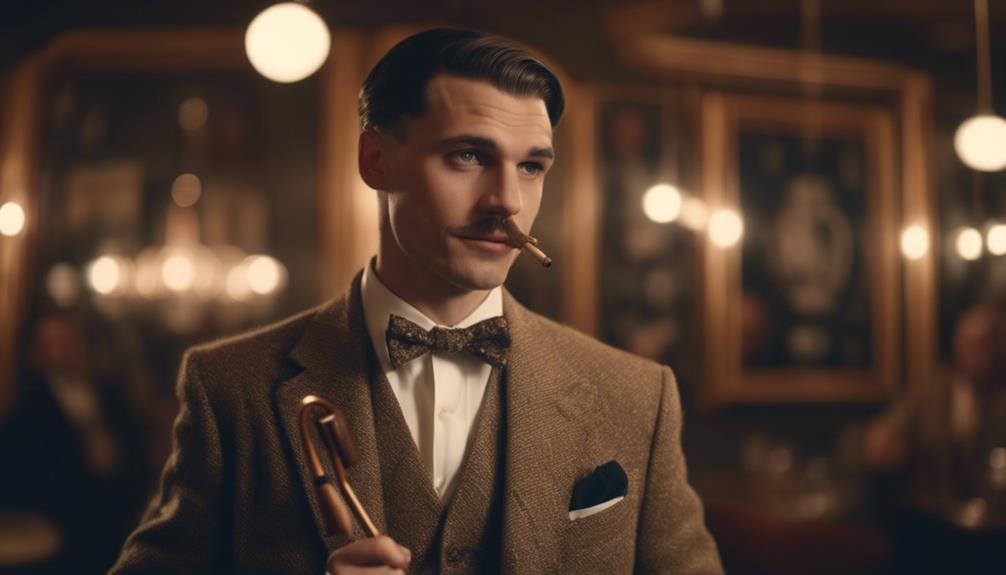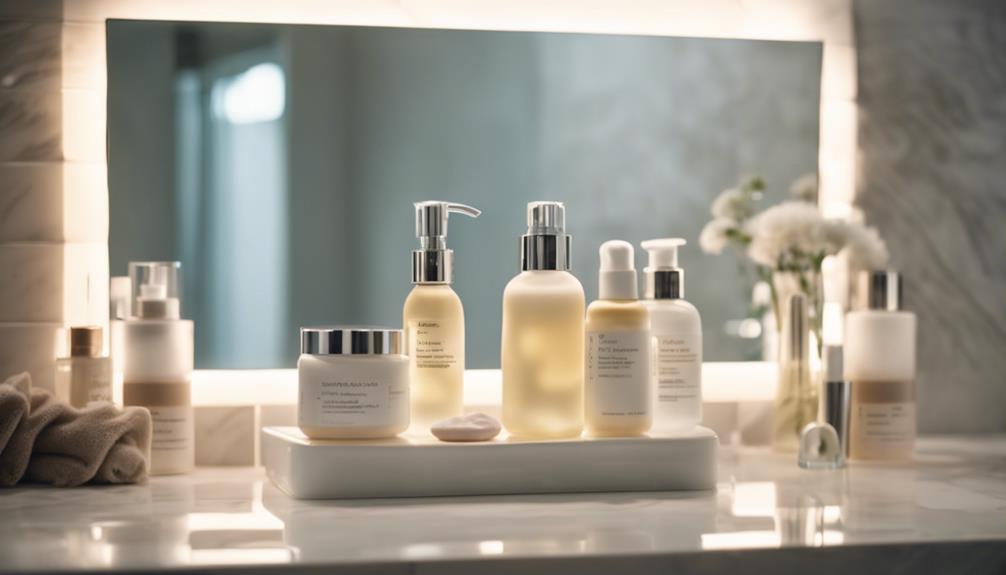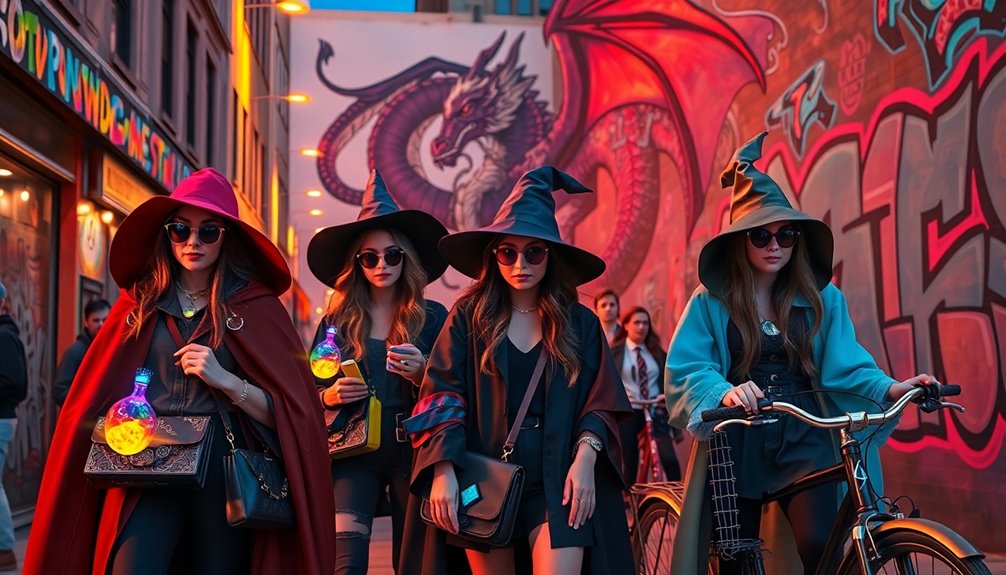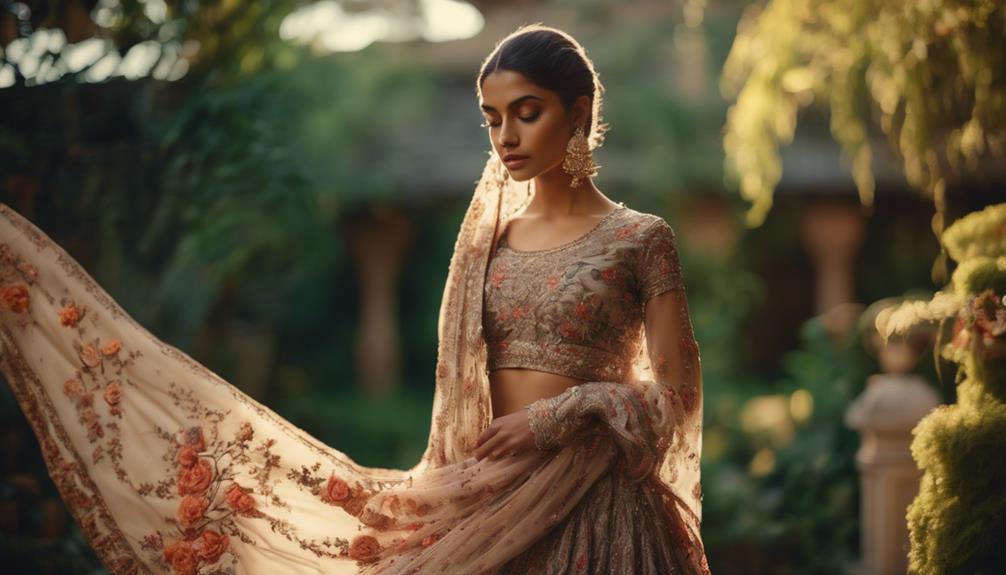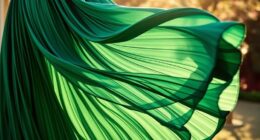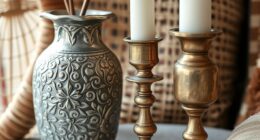In the 1920s, men’s fashion embraced stylish looks that exuded sophistication and flair, influenced by the vibrant Jazz Age. Men would wear well-fitted suits with sharp cuts, often featuring pinstripes in colors like navy and charcoal. Accessories such as pocket squares, cufflinks, and fedoras added personality and elegance to any ensemble. Fabrics like wool and silk ensured comfort, while bold ties brought a touch of individuality. This dynamic era redefined masculinity with a laid-back attitude, reflecting cultural changes and the excitement of nightlife. Stay tuned for more insights on the fashion trends of this iconic decade!
Key Takeaways
- The 1920s men's fashion embraced tailored fits with sharp lapels, often featuring bold patterns like pinstripes for a sophisticated appearance.
- Luxurious fabrics such as wool and silk were preferred, contributing to both comfort and elegance in men's attire.
- Accessories like pocket squares, cufflinks, and fedoras were essential for completing the dapper look of the era.
- The influence of jazz culture encouraged individuality, leading to relaxed yet stylish aesthetics in men's clothing.
Origin and historical background of the fashion trend/style
During the Jazz Age, you'll notice that men's fashion evolved dramatically alongside the rise of jazz music and flapper culture.
This period embraced a more relaxed yet sophisticated style, reflecting the excitement and social change of the time.
As you explore this fashion trend, you'll see how these cultural elements shaped the way men dressed in the 1920s.
Rise of Jazz Age Fashion
In the wake of World War I, the 1920s ushered in the Jazz Age, a period where men's fashion embraced bold expression and sophisticated style amidst significant social change.
You'll notice that tailored suits became the hallmark of this era, reflecting a shift towards individuality and luxury. As cultural movements gained momentum, men's attire transformed, incorporating vibrant colors and bold patterns that echoed the lively spirit of jazz music.
The influence of iconic figures, like Douglas Fairbanks, popularized this tailored elegance, while Prohibition's underground speakeasies encouraged a more relaxed yet refined look. Men began to favor looser fits and luxurious fabrics, moving away from the rigid styles of the past.
This newfound emphasis on individual expression allowed you to experiment with accessories, such as flamboyant ties and hats, that complemented your tailored suits.
The combination of European influences and the celebration of jazz further shaped this distinctive fashion narrative. Ultimately, the rise of Jazz Age fashion marked a significant departure from previous norms, paving the way for a more expressive and dynamic approach to men's style that resonated throughout the decade.
Flapper Culture and Jazz Music
Flapper culture emerged in the 1920s, embodying a spirit of liberation that not only transformed women's fashion but also inspired men to adopt a more relaxed and stylish aesthetic. This cultural shift coincided with the rise of jazz music, which became the soundtrack of the Roaring Twenties, energizing the social scene and encouraging bold fashion choices.
As men flocked to speakeasies and jazz clubs during the Prohibition era, they embraced dapper styles characterized by tailored suits and stylish accessories that conveyed sophistication and flair. Jazz icons like Duke Ellington and Louis Armstrong not only changed the music landscape but also influenced men's fashion, pushing them to experiment with their looks.
The vibrant beats of jazz music encouraged a sense of self-expression, prompting men to embrace innovative designs that reflected their individuality. This fusion of flapper culture and jazz music created a dynamic environment where men felt empowered to showcase their unique identities through fashion.
Ultimately, the 1920s became a decade where stylish accessories and dapper styles became essential components of a man's wardrobe, reflecting the cultural zeitgeist of freedom and creativity.
Key Characteristics
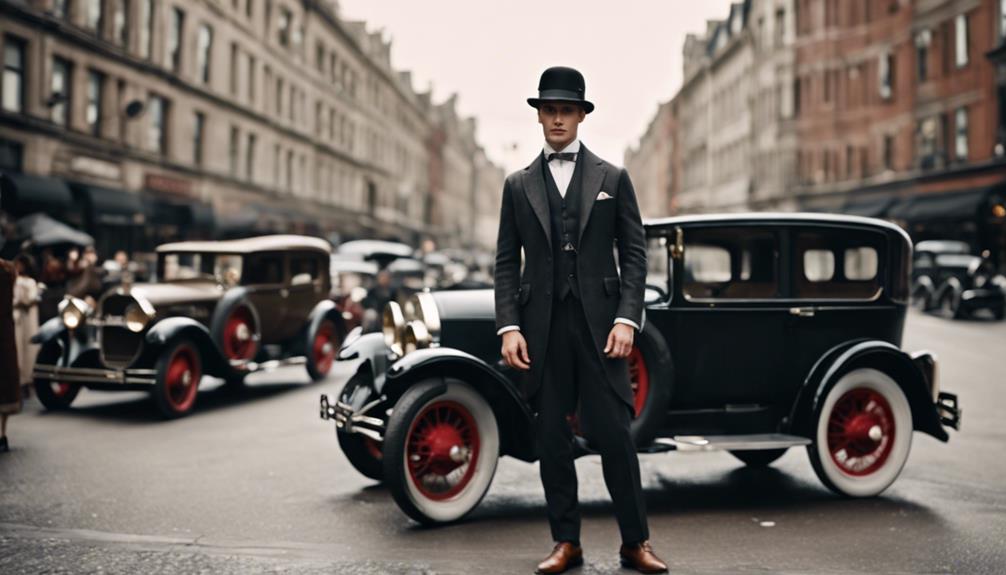
When you think about 1920s men's fashion, tailored fits and pinstriped patterns immediately come to mind.
You'll notice that fabrics like wool and silk dominated the era, often in muted tones that exuded sophistication.
This combination of sharp tailoring and rich textures defined the stylish look of the decade.
Pinstriped Patterns and Tailored Fits
Pinstriped patterns regularly defined the tailored suits of the 1920s, adding sophistication and a sense of verticality to men's fashion. When you think of this era, envision tailored fits that emphasize boxy silhouettes with wide lapels and pleated trousers. These styles reflect a perfect blend of comfort and elegance, making every man feel dapper.
During this time, the use of lighter fabrics allowed for looser fits, which were both breathable and stylish. This relaxed approach matched the vibrant social atmosphere of the Roaring Twenties. You'd find suits in eye-catching colors like navy blue and burgundy, often adorned with bold pinstripes. This combination created striking visual effects, showcasing individual flair.
Accessories played a vital role in enhancing the overall dapper appearance. Pocket squares, cufflinks, and stylish hats complemented pinstriped suits, making them even more appealing.
As you embrace the timeless charm of 1920s men's fashion, remember that the right mix of pinstriped patterns and tailored fits can elevate your wardrobe and make a lasting impression. So, get ready to step out in style and channel that iconic dapper look!
Wool, Silk, and Muted Tones
Building on the stylish foundation laid by tailored fits, the 1920s embraced luxurious fabrics like wool and silk, which enhanced men's fashion with their comfort and elegance.
Wool became a go-to choice for tailored suits, celebrated for its durability and versatility. You'd often see patterns like tweed, flannel, and houndstooth, adding character to your wardrobe while maintaining a polished look.
Silk, on the other hand, emerged as a favored material for accessories, such as ties and pocket squares. This addition brought a touch of luxury and refinement, elevating even the simplest outfits.
The color palette during this era leaned heavily towards muted tones, with navy blue, charcoal gray, and burgundy taking center stage. These colors reflected a shift towards sophistication, moving away from the more conservative hues of previous decades.
The combination of vibrant patterns and muted tones created a balanced aesthetic that appealed to the modern man. Bold designs were grounded by classic, understated colors, allowing you to express your style while embracing a refined look.
In this way, the 1920s truly defined a new era in men's fashion, blending comfort, elegance, and sophistication seamlessly.
Tailored Wool Suits
Tailored wool suits in the 1920s are defined by their boxy silhouettes, wide lapels, and a looser fit that prioritizes comfort and mobility. You'll find these suits often made from durable and breathable fabrics like tweed and lightweight wool, perfect for a variety of occasions.
The suits typically feature pleated trousers and can come in single or double-breasted styles, allowing you to express your personal flair. The color palette is rich, with shades like navy blue, charcoal gray, and burgundy taking center stage. Bold patterns, including checks and pinstripes, add an eye-catching touch to your ensemble.
To elevate your look, don't forget the accessories! Pocket squares, ties, and stylish hats are essential to achieving that dapper aesthetic the 1920s are known for.
Whether you're attending a formal event or a casual gathering, a well-fitted tailored wool suit can make a lasting impression. Embrace the charm of the Roaring Twenties and showcase your style with confidence!
Modern Interpretation
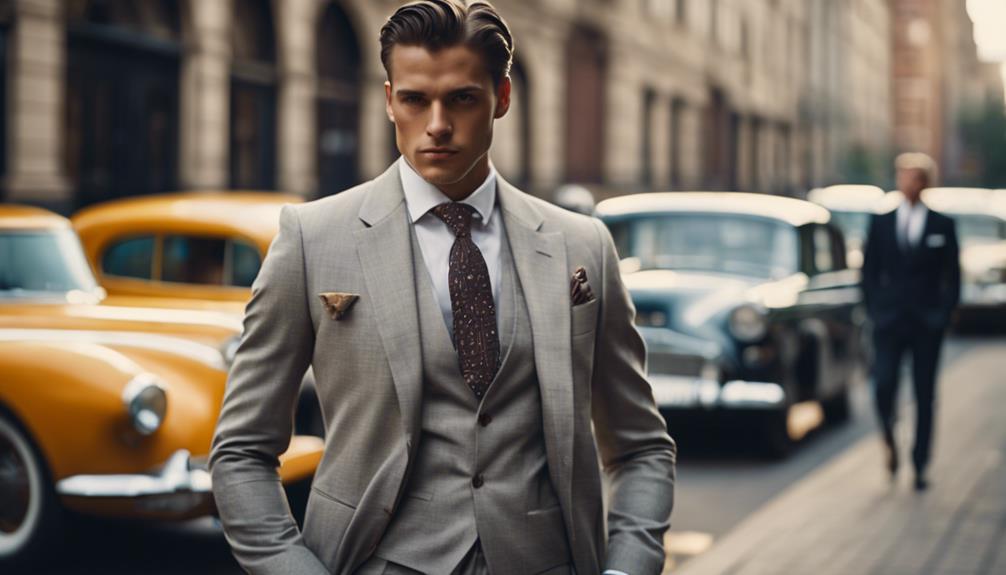
When you think about modern interpretations of 1920s men's fashion, consider how sustainable practices and heritage tailoring houses are reshaping the look.
You might also notice the influence of Hollywood stars from that era, which adds a timeless flair to contemporary styles.
This blend of past and present not only honors the original designs but also makes them relevant for today's fashion scene.
Sustainable Fashion Practices
Sustainable fashion practices today revive the elegance of the 1920s by focusing on high-quality, durable pieces that stand the test of time. You'll find that tailored pieces made from durable fabrics not only enhance your style but also contribute to a more sustainable wardrobe. By embracing eco-friendly materials like organic cotton and linen, you can wear fashion that's both stylish and environmentally responsible.
The trend emphasizes the importance of reusing and repurposing garments, steering clear of the throwaway culture of fast fashion. Many brands are adopting slow fashion principles, echoing the bespoke tailoring craftsmanship of the 1920s, where quality trumps quantity. This shift allows you to invest in timeless designs that don't just follow seasonal trends but are crafted to last.
As you curate your wardrobe, consider incorporating classic accessories and tailored suits that reflect this sustainable approach. These choices not only enhance your fashion sense but also promote responsible consumption. By prioritizing these sustainable fashion practices, you're not just dressing well; you're making a statement about the kind of world you want to support.
Heritage Tailoring Houses
Heritage tailoring houses continue to breathe life into the elegance of the 1920s, crafting high-quality garments that reflect timeless style and modern sophistication. These establishments uphold the traditions of bespoke tailoring established during the Roaring Twenties, ensuring every piece is tailored to your specifications. Today, you can find modern interpretations of classic styles, featuring wide lapels, double-breasted suits, and luxurious fabrics like tweed and silk.
Many heritage brands pay homage to iconic 1920s figures, drawing inspiration from their signature looks while blending historical significance with current fashion sensibilities. You'll notice vintage elements, such as patterned waistcoats and vibrant colors, that capture the bold aesthetics of the Jazz Age, appealing to those seeking both classic and trendy styles.
The resurgence of interest in 1920s fashion has sparked collaborations between modern designers and heritage tailoring houses, resulting in limited-edition pieces that merge traditional craftsmanship with contemporary flair. By embracing these dapper styles, you can effortlessly incorporate the elegance of the past into your wardrobe, showcasing a refined sense of style that stands the test of time.
Hollywood Stars of the Era
Hollywood stars of the 1920s, like Douglas Fairbanks and Rudolph Valentino, set the stage for modern interpretations of dapper men's fashion, showcasing tailored suits that exuded glamour and sophistication. These Hollywood icons embodied the era's elegance, inspiring today's fashion trends with their chic ensembles. You can easily spot their influence in contemporary tailored suits featuring vibrant colors and luxurious fabrics.
The classic three-piece suit remains a staple, blending timeless style with modern comfort. Bow ties, often paired with these suits, add a touch of whimsy and refinement, echoing the charm of the past. Polished shoes complete the look, ensuring you step out in style, just like the stars of yesteryear.
Accessories also play a crucial role in achieving these dapper styles. Fedora hats, pocket squares, and cufflinks not only elevate your outfit but also pay homage to the sophistication of the 1920s.
As you embrace these elements, you'll discover how the fashion choices of Hollywood legends continue to inspire your own wardrobe, making you feel like a true icon of today.
Styling Tips
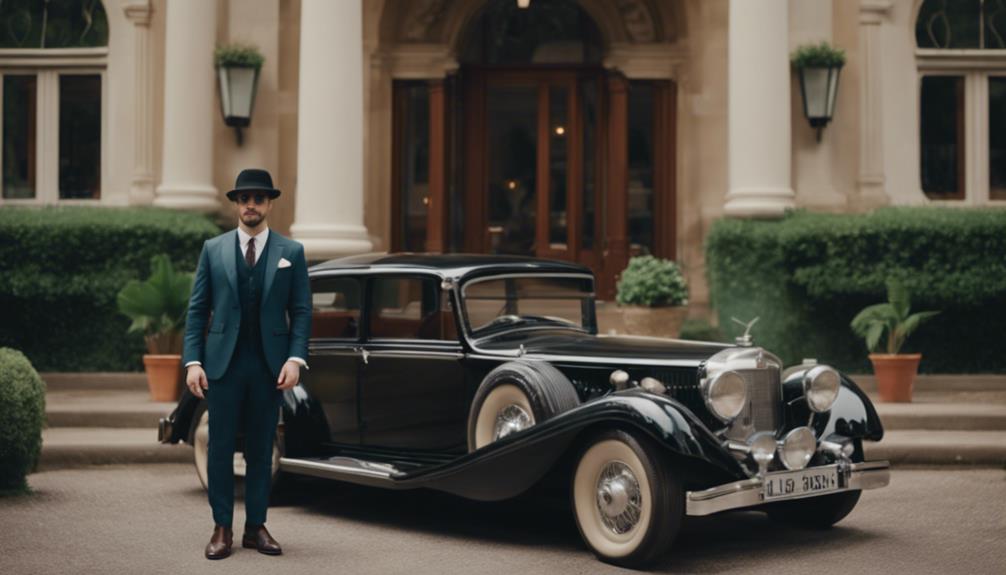
To nail the 1920s look, you'll want to start with a classic fedora and a sharp tie that captures the era's charm.
Don't underestimate the power of dapper accessories; they can really elevate your style and make a statement.
Layering textures and patterns will help you stand out while still embracing that timeless sophistication.
Classic Fedora and Tie
When you combine a classic fedora with a tie, you instantly elevate your style, capturing the essence of 1920s men's fashion. The classic fedora, with its soft brim and pinched crown, suits both formal and casual occasions, making it a versatile accessory. To create a polished look, coordinate the colors or patterns of your fedora and tie. A patterned tie can beautifully complement a solid-colored fedora, adding visual interest and flair.
In the Roaring Twenties, ties were often broader and made of luxurious silk, featuring vibrant colors and bold patterns that embody self-expression. Don't shy away from experimenting with different combinations to showcase your personality. A well-placed pocket square can also enhance your outfit, whether you choose classic white or a contrasting color to add sophistication.
Ensure your fedora sits comfortably, neither tilting too far forward nor back, while your tie should be neatly knotted. This attention to detail reflects the polished style of the era.
Dapper Accessories for 1920s Looks
Incorporating dapper accessories into your outfit not only enhances your 1920s look but also allows you to express your unique style and sophistication. To elevate your appearance, consider adding cufflinks and collar pins to your formal looks. These subtle yet impactful accessories come in various designs and materials, providing a touch of elegance to any ensemble.
Don't forget about stylish footwear; leather Oxfords are a quintessential choice for completing dapper 1920s outfits. Look for pairs with wingtip detailing or two-tone designs that blend elegance with practicality. A classic fedora or bowler hat can also add a striking element to your look, especially when adorned with feathers or ribbons.
Vintage-inspired gloves are another fantastic addition, offering both functionality and a polished finish to your outfit. Finally, consider suspenders for a timeless touch that keeps your trousers in place while contributing to your overall refined aesthetic.
Layering Textures and Patterns
Layering textures and patterns is a key technique for achieving a standout 1920s men's look that exudes sophistication and personal style.
Start with tailored suits made from rich materials like tweed or wool, and don't shy away from mixing patterns such as checks, stripes, or houndstooth. This balance of boldness and subtlety allows you to express your individuality while maintaining that dapper aesthetic.
Incorporate a pastel waistcoat under your suit jacket for a touch of contrasting color that really pops. This layering approach not only adds visual interest but also enhances the overall elegance of your outfit.
Don't forget about accessories! A pocket square or a patterned tie can infuse your look with vibrant hues and intricate designs, perfect for complementing your layered textures.
For a cozy yet stylish vibe, try adding knitted sweaters or vests beneath your jackets. This practice offers both comfort and a dash of sophistication, showcasing your unique flair.
Shopping Guide
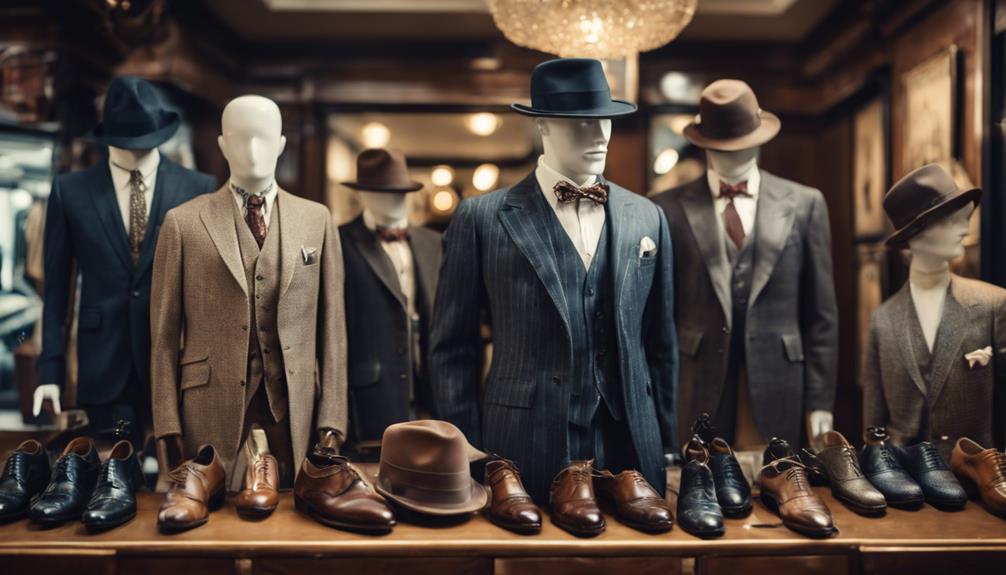
To nail that classic 1920s look, focus on tailored three-piece suits with wider lapels and eye-catching colors like navy and pastels. This style captures the youthful sophistication of the era, making it perfect for formal wear.
When shopping, prioritize natural fabrics such as wool and cotton to guarantee comfort and authenticity in your outfits.
In your search, don't forget the accessories that elevate your ensemble. Pocket squares, bow ties, and cufflinks were essential during the Roaring Twenties, adding elegance and personal flair to your look. They're a must-have in any men's fashion guide focused on this period.
For footwear, opt for leather Oxfords or two-tone shoes, as these choices reflect the fashionable styles of the 1920s. They'll complement both formal and casual outfits seamlessly.
Vintage Fabric Repurposing Ideas

If you've got some vintage fabrics lying around, you can easily upcycle them into stylish new pieces.
Think about turning old suit materials into trendy shorts or vests that capture the essence of the 1920s.
With a little creativity, you'll blend classic charm with modern flair in no time.
Vintage Fabric Upcycling Techniques
Embracing vintage fabric upcycling techniques lets you transform historical garments into unique, stylish pieces that reflect the charm of 1920s men's fashion. By repurposing vintage fabric made from natural fibers like wool, cotton, and silk, you engage in sustainable fashion practices that pay homage to past styles.
One popular method is patchwork, where you sew pieces of vintage fabric together to create eye-catching items such as bags or quilts, showcasing the vibrant patterns of the era. You can also craft accessories like bow ties or pocket squares from leftover scraps, preserving the unique textures that defined 1920s menswear.
Additionally, consider applying visible mending techniques to enhance the aesthetic of your vintage fabric garments while extending their lifespan. This resourcefulness echoes the spirit of the 1920s, a time of innovation and creativity.
Upcycle Vintage Suit Fabrics
Upcycling vintage suit fabrics offers a fantastic way to breathe new life into old garments while creating stylish, one-of-a-kind pieces that celebrate the elegance of 1920s menswear. By creatively repurposing these luxurious materials, like wool and tweed, you can contribute to sustainable fashion while showcasing your unique style.
Consider transforming vintage suit jackets into trendy bags or vests, utilizing the high-quality fabrics that define the era. With techniques like patchwork, embroidery, or dyeing, you can enhance the aesthetic appeal, infusing modern designs with historical charm. Imagine a chic tote made from a repurposed suit jacket, combining practicality with dapper sophistication.
Not only does upcycling reduce textile waste, but it also preserves the craftsmanship and timeless style of vintage suits. Each piece you create tells a story, reflecting both your creativity and the rich history of menswear.
Embracing this practice not only elevates your wardrobe but also aligns you with the values of sustainability and individuality in fashion. So, immerse yourself in your collection of vintage suit fabrics and start crafting pieces that aren't only stylish but also environmentally conscious.
Cultural Impact
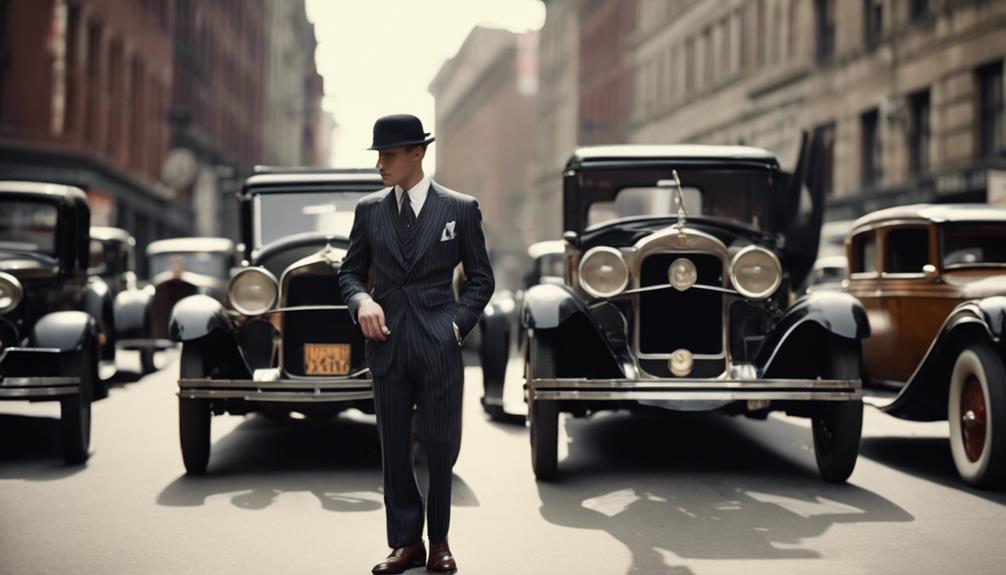
The 1920s brought a cultural revolution that dramatically influenced men's fashion, fueled by the Charleston dance craze and the rebellious spirit of Prohibition.
As nightlife flourished, men began to adopt bold styles that complemented the energetic social scene.
This era's fashion choices reflected a break from tradition, emphasizing individuality and sophistication in a rapidly changing world.
Charleston Dance Craze Influence
Influenced by the Charleston dance craze, men's fashion in the 1920s transformed to reflect a more dynamic and expressive style that matched the energetic rhythms of the era.
As the Charleston gained popularity, you'd notice a shift towards looser-fitting suits and casual attire that allowed for greater freedom of movement on the dance floor. This newfound comfort was essential for maneuvering the lively dance halls where the Charleston flourished.
Bright colors and bold patterns became staples in men's wardrobes, embodying the upbeat spirit of the time. You could often see stylish outfits that highlighted dapper looks, showcasing individuality and flair.
The Charleston's connection to the flapper movement further influenced men's fashion, encouraging tailored suits designed to complement the fashionable women around you. This collaboration created a cohesive aesthetic, marrying sophistication with a playful sense of self-expression.
Fashion icons, like Josephine Baker, brought visibility to this stylish menswear, inspiring you to embrace dapper styles that celebrated your personality.
The Charleston didn't just change how men dressed; it reshaped the culture of fashion, allowing for a vibrant expression of identity during the Jazz Age.
Prohibition and Fashion Rebellion
As the Charleston dance craze transformed men's fashion, Prohibition sparked a rebellion that pushed styles toward boldness and freedom, reflecting a desire to break away from societal constraints. The underground bars, or speakeasies, became hotspots for self-expression, where you'd see flamboyant styles emerging in menswear.
With the rise of gangster culture, tailored suits gained prominence, characterized by wide lapels and pinstripes, signaling a defiance against authority and traditional fashion norms.
F. Scott Fitzgerald's iconic character, Jay Gatsby, epitomized this fusion of luxury and rebellion. Gatsby's extravagant wardrobe showcased the era's fashionable defiance, making tailored suits a symbol of status in a time of prohibition.
As societal expectations loosened, men began adopting a more casual approach to dressing, favoring bolder colors and patterns that reflected their individuality.
The fashion rebellion of the 1920s marked a significant shift in men's styles, driven by the desire to express oneself freely. Prohibition didn't just restrict alcohol; it ignited a transformation in how men viewed their clothing, encouraging them to embrace a more daring and expressive aesthetic.
Frequently Asked Questions
How to Dress for a Roaring 20S Party for Men?
To dress for a Roaring 20s party, you'll want a tailored three-piece suit in bold colors. Accessorize with a bow tie, pocket square, and classic footwear like two-tone Oxfords to complete your sophisticated look.
What Did the Men Wear in the Roaring 20s?
In the Roaring 20s, you'll find men sporting tailored three-piece suits with wide lapels, bold-patterned shirts, and high-waisted trousers. Accessories like fedoras and cufflinks complete the look, embodying the era's elegance and flair.
Who Were the Male Fashion Icons of the 1920s?
In the 1920s, you'd see male fashion icons like Douglas Fairbanks, Rudolph Valentino, and Al Capone. Their distinctive styles set trends, combining elegance with boldness, influencing how men dressed for both casual and formal occasions.
How to Dress Like a Dapper Man?
To dress like a dapper man, embrace tailored suits, bold dress shirts, and high-waist trousers. Accessorize with pocket squares and stylish hats, while choosing polished leather shoes for that perfect touch of elegance.
Conclusion
In the 1920s, men's fashion defined a bold, dapper era that still influences styles today.
By embracing key characteristics of this trend, like tailored suits and accessories, you can channel that iconic look.
Whether you're shopping for vintage pieces or repurposing fabric, the spirit of the Roaring Twenties is within reach.
So, don't hesitate to incorporate these timeless styles into your wardrobe and celebrate the cultural impact of this remarkable decade!
